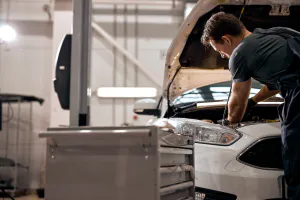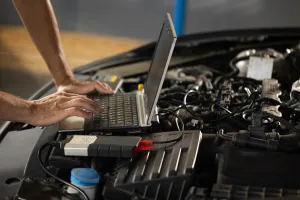Want to learn how to maintain your car yourself so you can enjoy better fuel economy, higher resale value, increased longevity, and fewer costly repairs? Check out these 10 car maintenance tips from our FIXD Mechanics! If you want to keep your vehicle in the best possible condition, but you don’t have a ton of money to throw at a repair shop or dealer… and you also don’t know the difference between a socket wrench and a monkey wrench, I’ve got good news:
You don’t have to be a mechanic to take excellent care of your car. In fact, there are many things the average person can do to keep their car running smoothly while saving money. Our FIXD Mechanics have broken them down here inside this easy-to-follow guide.
Read Your Owner’s Manual
Who actually does that? Well, people who want to make their car last and avoid preventable repairs. Truth is, your owner’s manual is chock-full of important maintenance information that will make you feel more confident as a hands-on car owner.
Your owner’s manual contains essential information, such as how to best care for your specific vehicle, when to check or replace vehicle components, how often to service your vehicle, what grade of gasoline to use, and much more.
Once you’ve familiarized yourself with your vehicle’s unique needs, you can use the FIXD Sensor and free app to track your maintenance intervals and ensure you never miss an oil change or tire rotation!
Do These 3 Things Every Other Fill-Up:
1. Clean the windshield.
A dirty windshield can block your view and create a safety hazard on the road. Take 5 minutes to use the squeegee at the gas station to clear your windshield and stay safe.
Be sure to keep your headlights clean, too. If yours are cloudy, check out our guide on how to restore your headlights to like-new condition.
2. Check tire pressure and treads.
Improperly inflated tires increase your chances of having a blow-out and reduce fuel efficiency. Check your tire pressure regularly to catch any issues early. Since tires rarely wear the same on all sides, it’s also important to look over the tires for any signs of damage or wear and have them rotated as recommended by your owner’s manual. A good rule of thumb to tell if you need new tires is The Penny Test.
3. Check fluid levels and top off as needed.
Fluids help keep your car properly lubricated and running as smoothly as possible. To keep your car in tip-top shape, check your oil, coolant, transmission fluid, brake fluid, power steering fluid, and washer fluids regularly.
Not sure how to use a dipstick? Click here to learn how to check your oil. It’s easy!
Check Your Battery
Like most parts of your vehicle, you probably never think about the battery until something goes wrong. (Which usually happens when you’re in a hurry or stranded in a parking lot, right?) By keeping tabs on your battery, you’ll know when it’s time to replace it so you don’t get blindsided.
It’s a good idea to check your battery annually, more often if you notice signs of weakness or if your battery is 3-5 years old. Signs of a weak battery include slow starts, dim headlights or lack of power to the electronics, heavy corrosion on the terminals, and of course, a vehicle that won’t start.
By using a volt meter or the FIXD Sensor, you can get an accurate reading of your car battery’s voltage in seconds.
A battery is considered fully charged at 12.6 volts or higher. Even the slightest drop in voltage can make a big difference in the vehicle. At 12.4 volts, the battery is considered charged, but only at 75%. If the battery reads 12 volts and below, the car may not start. A battery by industry standard is considered discharged at 12.39 volts or less.
If your battery voltage is low (or the battery is completely dead) because you simply left the lights on, for example, jump start your vehicle and recharge it by driving around.
However, if you’re experiencing signs of a weak battery and your car battery isn’t holding a charge, follow these steps to replace your car battery. It’s a great skill to learn as a beginner and only takes a couple of hours!
Change Your Oil at the Right Time
Oil is the lifeblood of your vehicle. Your car needs oil and proper oil pressure for lubrication and performance adjustments made while you’re driving. In other words, it keeps things running smoothly.
By following your factory recommended maintenance intervals, you can extend the life of your vehicle and avoid paying hundreds or thousands in completely preventable engine damage.
Many service providers recommend changing your oil every 3,000 miles. But all those service fees add up quickly. With today’s fuel-delivery systems and modern manufacturing, many vehicles won’t need an oil change for 7,500-10,000 miles (with the exception of extreme driving conditions).
Always check your owner’s manual for the factory recommended oil change intervals for your specific vehicle. And if you want to save money and learn an important lifelong skill, check out our comprehensive guide on how to change your car’s oil. You’ll discover how to know when it’s time for an oil change, the best type of oil to use with your car, and how to change your oil at home.
Replace Your Air Filter to Maximize Fuel Efficiency
Your car’s engine air filter is a critical component for keeping debris out of the engine so it can perform at its best. But did you know that replacing your air filter in a timely manner can help reduce engine wear, improve acceleration, and increase gas mileage by as much as 10%?
The best part? Changing your air filter at home typically costs less than $20 and requires zero specialized knowledge or tools.
You should always read your owner’s manual for the most accurate recommendations, but many manufacturer’s recommend replacing the engine air filter every 30-45,000 miles.
If you live in an area with more dust and contamination, then this interval may be shorter. If you’re wondering if it’s time to change your air filter, check it for black spots and grime.
Read Car Engine Air Filters: A Complete Guide for more information on how to change your air filter yourself and save a trip to the mechanic!
Replace Windshield Wipers
Wiper blades should be replaced about every 6 months, or whenever you notice issues while driving. As they lose contact with the windshield, they may start to squeak, leave streaks, or smear, making it hard to see the road.
Wondering how to pick the perfect wipers for your vehicle? Check out this article on How To Choose The Best Windshield Wipers 2020. We’ve also created a simple walk-through video to show you how to install your car’s windshield wipers with ease.
Replace Headlight Bulbs
Changing your headlights and taillights when they burn out is a simple fix that will keep you and others safe, and ensure you avoid a ticket.
Before replacing your bulb, make sure you’ve got the right one by taking the blown light to your local auto parts store. Then follow along with our tutorial that shows you exactly how to replace your headlight bulb in 4 easy steps.
Clean EGR Valve and EGR Ports
What is an EGR valve? EGR valves stop nitrogen oxide pollution, which are bad for your car, your health, and the environment. If the EGR valve becomes clogged, it can cause engine knocking and, worst case scenario, catastrophic engine failure.
If your EGR valve is malfunctioning, you may fail emissions testing or get a warning light that reads as code P0401 on your FIXD Sensor.
By keeping your EGR valve and ports clean, you can avoid any harmful buildup and save yourself the trouble of having them replaced! All you need are a few basic tools and to follow these steps to clean an EGR valve.
Confidently Care for Your Car with FIXD
With the FIXD Sensor and free app, you can not only find out what the check engine light means in plain English, but you can also get a list of possible solutions, track routine maintenance and battery life, monitor the health of all your vehicles from one phone, and much, much more. There’s no simpler way to get started and save money!

Wife, mom, Content Manager & Senior Copywriter at FIXD. From the garage to the gym, I love helping people learn and grow. Dream car: ‘69 Acapulco Blue Mustang.












